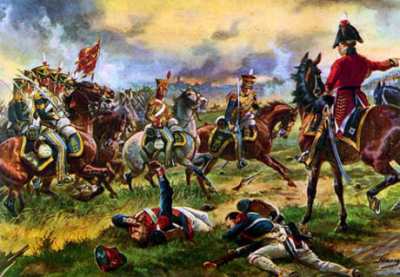The Spanish Irregulars
On the 21st of June 1813 Wellington’s 10th Hussars drunk champagne from the chamber-pot of King José-Napoleon. Brother of Bonaparte and the cat’s-paw regent to the Spanish throne. The Anglo-Portuguese Army had routed the French, plundered their baggage train and were duly celebrating their victor’s fruits after the Battle of Vitoria. One hopes they found time to disinfect the bed-pan.
The Battle at Vitoria was the end-games to what became known to the British as The Peninsular War. To the French it was the Guerre d’Espagne, to the Portuguese The French Invasions. To the Spanish themselves it was their War of Independence.

The Battle of Vitoria June 21 1813. British light dragoons about to charge.
Photo www.britishbattles.com
It was in Andalucía on the 19th of July 1808 that arguably the pivotal event of the war occurred. At Bailén in the province of Jaén the Napoleonic land Army suffered its first major defeat. A French Army of 23,000 under the command of General Dupont engaged a Spanish force led by General Castaños. Out manoeuvred and out fought, Dupont surrendered. Some 17,635 prisoners were taken and José-Napoleon abandoned Madrid in favour of the relative safety offered by Vitoria. The Spanish had shown that the forces of Napoleon were not invincible.
An outraged Napoleon personally led an army of 135,000 which swept across the peninsular. Napoleon staged victory marches throughout all the provinces, but it was an illusion. Although he defeated the Spanish regular army at every occasion, he never totally destroyed it. It was always waiting in the undergrowth ready to leap out and savage him. However, the main threat to the French was not from the Spanish regulars but from the Guerrillas.
Men and women appalled at the excesses of the French troops took up arms. Bands of up to 2000 ranged through the length and breadth of Spain. They attacked French supply columns, dispatch riders, stragglers and any other convenient target.
Napoleon referred to their activities as a Spanish Ulcer. The actions of the Guerrillas was to have a profound effect on the outcome of the war in the Peninsular.
The British realised the importance of Castaños's victory and the resistance of the Guerrillas. In the autumn of 1810 Wellesley had 25,000 British with another 25,000 Portuguese regulars operational in the peninsular. The French however now numbered 350,000.
So why did Britain and the future Duke of Wellington Prevail?
Of the 350,000 French soldiers in the field, something in the order of 200,000 became necessary for escort duties. A dispatch rider sometimes needed an escort of up to 2000 men to guarantee getting to his destination. Convoys demanded massive protection making them complex and cumbersome.
The Guerrillas passed captured despatches to the British, shadowed French columns and harassed their escorts. They attacked supply columns from ambush and before reinforcements could arrive, disperse. The Guerrillas would then reform, perhaps weeks later to cause more mayhem amongst the demoralised French.
Summing up the feeling of the French in Spain, Blaze an army pharmacist said “The French army, spread in all provinces of the Peninsula, was surrounded by enemies yet had no army to fight. The guerrillas showed themselves everywhere, but one did not meet them anywhere; they were invisible enemies who dispersed or rallied at the call of their chiefs”
Who leads these bands of legalised Bandoleros?
Every province had its Guerrilla, from Asturias where Juan Diaz Porlier, El Marquesto operated to Andalucía and the Malagueño Vincente Moreno Romero. Juan Martin Diaz, El Empecinado was arguably the most famous. Born near Burgos, El Empecinado was originally a farm worker, but by 1811 he commanded a Guerrilla of almost 3000 infantry and 1000 cavalry.
El Empecinado was such a problem to the French that they sent entire columns to track him down, all to no avail however. El Empecinado (The Obstinate One) and his men became incorporated in the regular Spanish army.
Many men and women threw in their lot with the Guerrilla bands due to the excesses of the French invaders. Motivated by thoughts of revenge they exacted their own form of retribution from their prisoners. The Frutos Francese was a common sight after an attack, with the hapless French hanging from trees.
Jeronimo Merino, El Cure outraged at the wanton behaviour of the French in his home village of Valloviado raised a Guerrilla of 2500 men. His speciality was the castration of captured French officers. Somewhat strange conduct for a parish priest, but such was his contempt for the foul behaviour of his enemies.
Ambrosio Carmena, El Pellejero became active after the vicious rape of his wife. His group operated near Toledo renowned for their ferocity. He declined all honours and pensions offered to him at the end of the war. Being able to return to his village and his tanner’s trade was all El Pellejero needed.
We can conjure up images of these men and women from the shadows of the past. We can see them in the low sierras ambushing a convoy or galloping across the plains pursued by sabre waving cavalry. Almost 200 years has passed since these patriots roamed the campo, unfettered by convention, righting wrongs, free-spirits laughing in the face of an Empire. The theme of every schoolboy's playtime. The stuff Hollywood revels in, but we forget that the realities were much harsher.
The references to the Guerrillas in British historical textbooks are few. Has the debt to the Spanish Irregulars been recognised? On the other hand would Spain have succeeded in evicting the French without the help of the British and Portuguese?
There are no statues to Wellington in Madrid or Vitoria!
John MacDonald - www.caratacus.eu
